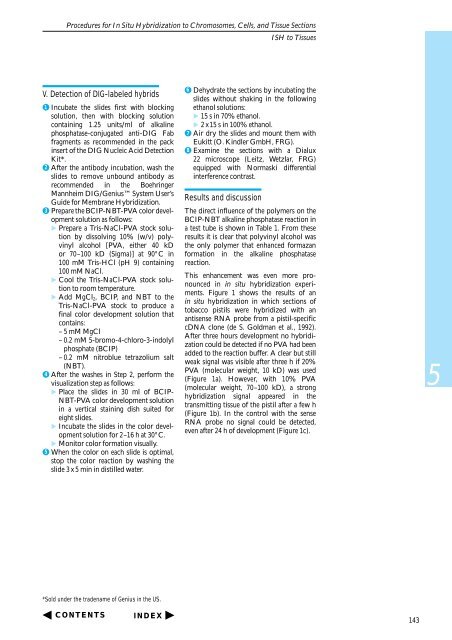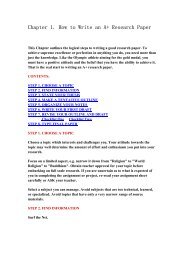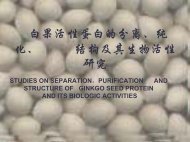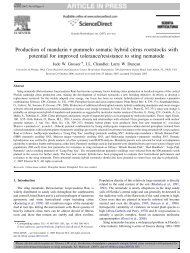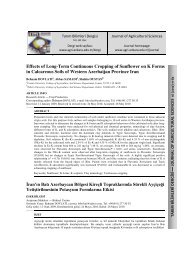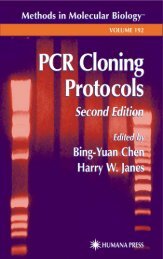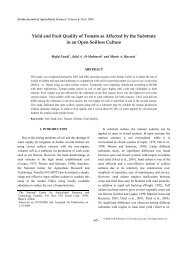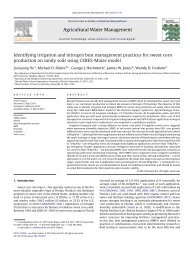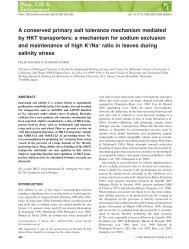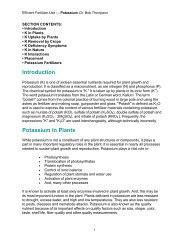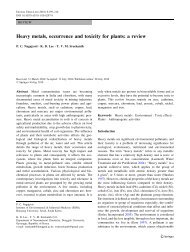General Introduction to In Situ Hybridization
General Introduction to In Situ Hybridization
General Introduction to In Situ Hybridization
Create successful ePaper yourself
Turn your PDF publications into a flip-book with our unique Google optimized e-Paper software.
Procedures for <strong>In</strong> <strong>Situ</strong> <strong>Hybridization</strong> <strong>to</strong> Chromosomes, Cells, and Tissue Sections<br />
ISH <strong>to</strong> Tissues<br />
V. Detection of DIG-labeled hybrids<br />
1 <strong>In</strong>cubate the slides first with blocking<br />
solution, then with blocking solution<br />
containing 1.25 units/ml of alkaline<br />
phosphatase-conjugated anti-DIG Fab<br />
fragments as recommended in the pack<br />
insert of the DIG Nucleic Acid Detection<br />
Kit*.<br />
2 After the antibody incubation, wash the<br />
slides <strong>to</strong> remove unbound antibody as<br />
recommended in the Boehringer<br />
Mannheim DIG/Genius System User’s<br />
Guide for Membrane <strong>Hybridization</strong>.<br />
3 Prepare the BCIP-NBT-PVA color development<br />
solution as follows:<br />
Prepare a Tris-NaCl-PVA s<strong>to</strong>ck solution<br />
by dissolving 10% (w/v) polyvinyl<br />
alcohol [PVA, either 40 kD<br />
or 70–100 kD (Sigma)] at 90°C in<br />
100 mM Tris-HCl (pH 9) containing<br />
100 mM NaCl.<br />
Cool the Tris-NaCl-PVA s<strong>to</strong>ck solution<br />
<strong>to</strong> room temperature.<br />
Add MgCl2, BCIP, and NBT <strong>to</strong> the<br />
Tris-NaCl-PVA s<strong>to</strong>ck <strong>to</strong> produce a<br />
final color development solution that<br />
contains:<br />
– 5 mM MgCl<br />
– 0.2 mM 5-bromo-4-chloro-3-indolyl<br />
phosphate (BCIP)<br />
– 0.2 mM nitroblue tetrazolium salt<br />
(NBT).<br />
4 After the washes in Step 2, perform the<br />
visualization step as follows:<br />
Place the slides in 30 ml of BCIP-<br />
NBT-PVA color development solution<br />
in a vertical staining dish suited for<br />
eight slides.<br />
<strong>In</strong>cubate the slides in the color development<br />
solution for 2–16 h at 30°C.<br />
Moni<strong>to</strong>r color formation visually.<br />
5 When the color on each slide is optimal,<br />
s<strong>to</strong>p the color reaction by washing the<br />
slide 3 x 5 min in distilled water.<br />
*Sold under the tradename of Genius in the US.<br />
CONTENTS<br />
INDEX<br />
6 Dehydrate the sections by incubating the<br />
slides without shaking in the following<br />
ethanol solutions:<br />
15 s in 70% ethanol.<br />
2 x15 s in 100% ethanol.<br />
7 Air dry the slides and mount them with<br />
Eukitt (O. Kindler GmbH, FRG).<br />
8 Examine the sections with a Dialux<br />
22 microscope (Leitz, Wetzlar, FRG)<br />
equipped with Normaski differential<br />
interference contrast.<br />
Results and discussion<br />
The direct influence of the polymers on the<br />
BCIP-NBT alkaline phosphatase reaction in<br />
a test tube is shown in Table 1. From these<br />
results it is clear that polyvinyl alcohol was<br />
the only polymer that enhanced formazan<br />
formation in the alkaline phosphatase<br />
reaction.<br />
This enhancement was even more pronounced<br />
in in situ hybridization experiments.<br />
Figure 1 shows the results of an<br />
in situ hybridization in which sections of<br />
<strong>to</strong>bacco pistils were hybridized with an<br />
antisense RNA probe from a pistil-specific<br />
cDNA clone (de S. Goldman et al., 1992).<br />
After three hours development no hybridization<br />
could be detected if no PVA had been<br />
added <strong>to</strong> the reaction buffer. A clear but still<br />
weak signal was visible after three h if 20%<br />
PVA (molecular weight, 10 kD) was used<br />
(Figure 1a). However, with 10% PVA<br />
(molecular weight, 70–100 kD), a strong<br />
hybridization signal appeared in the<br />
transmitting tissue of the pistil after a few h<br />
(Figure 1b). <strong>In</strong> the control with the sense<br />
RNA probe no signal could be detected,<br />
even after 24 h of development (Figure 1c).<br />
143<br />
5


